List of buildings at Marshall University
Marshall University in Huntington, West Virginia is home to many notable structures, including two residential high-rises.
Main campus buildings
| Building | Image | Constructed | Notes | Reference |
|---|---|---|---|---|
| Arthur Weisberg Family Applied Engineering Complex |  |
2015 | Includes the Arthur Weisberg Family Engineering Laboratories which was completed in 2008, are named for a donor family. | [1] |
| Bliss Charles Public Safety Building |  |
1995 | Houses MU Police Department | [2] |
| Brad D. Smith Center for Business and Innovation | Spring 2024* | New location for the Lewis College or Business on 4th Ave in Huntington, WV | ||
| Brad D. Smith Foundation Hall |  |
2010 | It houses the Erickson Alumni Center on the first floor. It is named for donors Brad D. Smith and Charlie O. Erickson respectively. | [3] |
| Buskirk Hall |  |
1965 | Originally West Hall, it is a female dormitory. It was renamed for a Lillian Helms Buskirk, who was dean of women from 1941 until 1970. | [4] |
| Cam Henderson Center |  |
1981 | Marshall's basketball arena, it also includes the Fitch Natatorium. Arena was named after former basketball coach, Cam Henderson. | [5] |
| Campus Christian Center |  |
1960/1961 | On private land surrounded by the campus and receives no state funding, and serves as a Protestant chapel. Eight Protestant denominations jointly manage the CCC. | [6] |
| Career Services Center |  |
1930 | Formerly a private home, was purchased in 1970. | [7] |
| Chris Cline Athletic Complex |  |
2014 | Indoor practice facility for the football program and houses an indoor track. It is named for donor, Chris Cline. | |
| Corbly Hall |  |
1980 | Classroom building named for former university president Lawrence J. Corbly. | [8] |
| Dot Hicks Field |  |
2008 | Marshall's softball field, named after a former professor | |
| Drinko Library |  |
1998 | Primary library on campus named for a donor, Dr. John Deaver Drinko. | [9] |
| Education Building | 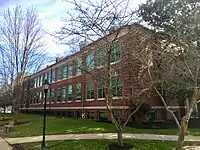 |
1937 | The building was originally Marshall College High School, and was renamed to Jenkins Laboratory School in 1937. It was named for Albert G. Jenkins. The building became a part of Marshall University in 1970. His name was removed from the building in 2020 | [10][11] |
| Edwards Performing Arts Center |  |
1992 | Expanded with the Jomie Jazz Center in 2000. Named for Joan C. Edwards in 1997, | [12] |
| Fred and Christine Shewey Athletics Building |  |
1992 | Connected to Edwards Stadium, it houses athletic department offices. | [13] |
| First-Year Residence Halls |  |
2008 | Consisting of Freshman North and Freshman South Hall. | |
| Gillette Welcome Center | 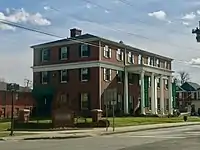 |
2007 | Former sorority house, was purchased in 2007 and is used by the admissions and recruitment. It was named for a donor, Joseph M. Gillette. | [14] |
| Gullickson Hall | 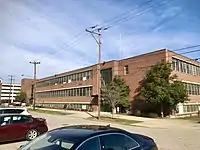 |
1961 | Original name was the Physical Education Building. It was renamed Gullickson Hall in 1963 after a physical education teacher, Otto Gullickson. | [15] |
| Harless Dining Hall |  |
2004 | Named for donor Buck Harless. | [16] |
| Harris Hall | 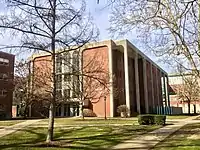 |
1976 | Classroom building named for former professor Arvil Ernest Harris. | [17] |
| Holderby Hall |  |
1963 | Originally South Hall, is a high-rise dormitory completed in 1963 and expanded in 1968. It was named for the original donor of the quarter acre of land in 1837 at the school's founding. | [18] |
| INTO Marshall University Building |  |
1943-1947 | The original dining hall, it was remodeled in 1975 as an office building. | [19] |
| Joan C. Edwards Stadium |  |
1991 | Marshall's football stadium named after Joan C. Edwards. The field is named after her husband, James F. Edwards. | [20] |
| Laidley Hall |  |
1937 | Small dormitory, named for the university's founder, John Laidley. | [21] |
| Marshall Commons | 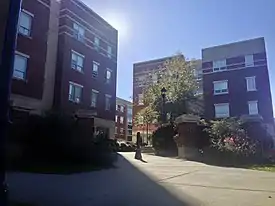 |
2003 | Consists of Gibson Hall, Wellman Hall, Haymaker Hall, and Willis Hall which are upper-division residence halls. | [22] |
| Memorial Student Center |  |
1971 | Named in honor of the 1970 football team. | [23] |
| Morrow Library | .JPG.webp) |
1930 | Former main library. With the completion of the Drinko Library, it is an auxiliary library and museum. It was named for former president James E. Morrow. | [24] |
| Myers Hall |  |
1992 | Used by the HELP (Higher Education for Learning Problems) program, a tutoring program for students with learning problems. It was named for a donor, Wilbur E. Myers. | [25] |
| Newman Center | 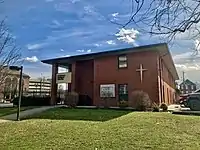 |
1981 | On private land surrounded by the campus and receive no state funding, and serves as a Catholic chapel. | [26] |
| Old Main |  |
1868 | Original building on campus and the symbol of the university. It was built between 1868 and 1908 and last remodeled in 2000. It currently is an office building. | [27] |
| One Room School House |  |
ca. 1888 | Built on the border of rural Mason and Cabell Counties at Glenwood, West Virginia, around 1889 and moved to the campus in 1995. It is a museum dedicated to the university's origin as a teacher's college. | [28] |
| Prichard Hall |  |
1955 | Originally a dormitory it was remodeled in 1973 into a classroom and office building. It was named for Lucy Prichard, a former professor. | [29] |
| Recreation Center |  |
2009 | It also houses the Wellness Center. | [30] |
| Robert C. Byrd Biotechnology Science Center |  |
2006 | Classroom building named for former United States Senator, Robert Byrd. | [31] |
| Robert L. Pruett Training Center |  |
2006 | Named for former football coach, Bob Pruett, it serves as a weight training center for student-athletes. | [32] |
| Science Building |  |
1950 | Expanded in 1984 and renovated in 1992 | [33] |
| Smith Hall |  |
1967 | Consists of Smith Hall, Smith Music Hall, the Communications Building and the Birke Art Gallery. It was named for former university president Stewart H. Smith and is the largest classroom building on campus. | [34] |
| Sorrell Maintenance Building |  |
1965 | Non-academic building used by the Buildings and Grounds division. Named for Howard Kenneth Sorrell in 1978. | [35] |
| Twin Towers |  |
1969 | Consisting of Towers East and Towers West it is the largest dormitory on campus. | [36] |
Medical and Forensic Science Facilities
The Medical Campus consists of several buildings in or near the Fairfield neighborhood of Huntington, in Huntington's east end neighborhood; and at the VA Medical Facility.
| Building | Image | Constructed | Notes | Reference |
|---|---|---|---|---|
| Coon Education Building | 1976 | Located seven miles from the main campus at 1542 Spring Valley Drive in the unincorporated suburb of Spring Valley, on the grounds of the United States Department of Veterans Affairs Hospital at Huntington. At one time it housed the complete School of Medicine. Today it continues to house the anatomy labs and research facilities. Named after former School of Medicine dean, Robert W. Coon. | [37] | |
| Erma Byrd Clinics | 2007 | Located at the former Fairfield Stadium site housing major new medical student teaching facilities and clinical education patient care clinics. Named after wife of United States Senator, Robert Byrd. | [38] | |
| Forensic Science Center | 2004 | Located in the remodeled 1971 football locker room complex from the otherwise demolished Fairfield Stadium. | ||
| Linda S. Holmes Student Wellness Center | 2019 | Located at 1321 Hal Greer Boulevard, it also houses the medical school’s student affairs and financial aid offices. Named after Linda Holmes, a former player and coach at Marshall. | [39] | |
| Medical Center | 1998 | Located at 1600 Medical Center Drive on the campus of Cabell Huntington Hospital is part of the Health Sciences Campus as well as the School of Medicine. | [40] | |
| School of Pharmacy | 2019 | Housed in Kopp Hall, which is located at the corner of Charleston Avenue and Hal Greer Blvd. It also contains a housing unit for married students. Named after former university President, Stephen J. Kopp. | [41] | |
| School of Physical Therapy | Located at the St. Mary's Medical Education Center on the campus of St. Mary's Medical Center at 3101 5th Avenue. |
Other Huntington Locations
| Building | Image | Constructed | Notes | Reference |
|---|---|---|---|---|
| President's House |  |
1923 | Located at 1040 13th Avenue. It was built in 1923 and acquired by the university in 1972 to replace a previous on-campus President's Home. The first floor is used for University functions and the second floor is the residence of the president. | [42] |
| Visual Arts Center |  |
2014 | Located in the former Stone & Thomas Department Store building in downtown Huntington across from Pullman Square, it was acquired by the university in 2013 and redeveloped in 2014. It is the home of the College of Art and Design and is a museum. | |
| Veterans Memorial Soccer Complex |  |
2013 | Located on the site of the demolished Veterans Memorial Fieldhouse at 2601 5th Avenue, 4 blocks from the main campus, it replaced Sam Hood Field, formerly on the site of the Chris Cline Athletic Complex. Full name is Hoops Family Field at Veterans Memorial Soccer Complex. |
University Heights
An area on the outskirts of town was used as the West Virginia Colored Children's Home (by that time it was actually being used as a sanitarium for elderly black men) and the surrounding farm land (in that era state institutions grew much of their own food) was transferred to the university at the end of segregation as "University Heights", with the intention of developing a second campus. The building was converted into housing for married students, along with a few new apartment buildings, but the property was never developed fully, being used for storage, a baseball field (which was not adequate for the team's needs and eventually abandoned), and much of the property was transferred to other state agencies over the years. In 2011 the buildings were demolished and the remaining property was transferred to the Cabell County Board of Education for a new middle school.
Marshall University – South Charleston Campus
Located in South Charleston, West Virginia at One Angus E. Peyton Drive.
Graduate College Administration Building, completed 1990.
Byrd Academic and Technology Center, completed 1995.
Byrd Institute
The Robert C. Byrd Institute, a non-academic technology transfer division of the university maintains:
RCBI Huntington at 1050 4th Avenue, a former bank building donated to the university.
RCBI South Charleston, on the South Charleston Campus.
RCBI Rocket Center, at 410 State Route 956, on the grounds of the United States Navy Allegheny Ballistics Laboratory.
RCBI Bridgeport, at 2400 East Bennedum Industrial Drive, a NASA facility.
Statewide Extension
The school also has the following off-campus instruction sites. The owned Mid-Ohio Valley Center at One John Marshall Way in Point Pleasant, the leased Teays Valley Center at One Carriage Point in Hurricane, and on the campus of the Southern West Virginia Community and Technical College in Logan and Williamson. The university also has an ownership interest in the Erma Byrd Higher Education Center in suburban Beckley, along with Concord University and Bluefield State College.
The Marshall University Rural Health Clinic, a part of the medical school, is located on Airport Road in Chapmanville, West Virginia.
In 2017, the medical school acquired the former Patriot Coal office building in Scott Depot and converted into the clinical offices as Marshall Health-Teays Valley. It is located at 300 Corporate Center Drive.
References
- Arthur Weisberg Family Applied Engineering Complex
- Public Safety Building
- Brad D. Smith Foundation Hall
- Buskirk Hall
- Cam Henderson Center
- Campus Christian Center
- Career Services Center
- Corbly Hall
- Drinko Library
- Jenkins Hall
- Stuck, Taylor (2020-07-07). "MU board votes to remove 'Jenkins' name from education hall". The Herald-Dispatch. Archived from the original on 2020-07-09. Retrieved 2020-07-09.
- Joan C. Edwards Performing Arts Center
- Fred and Christine Shewey Athletics Building
- Gillette Welcome Center
- Gullickson Hall
- Harless Dining Hall
- Harris Hall
- Holderby Hall
- INTO Marshall University
- Joan C. Edwards Stadium
- Laidley Hall
- Marshall Commons
- Memorial Student Center
- Morrow Library
- Myers Hall
- Newman Center
- Old Main
- One Room School House
- Prichard Hall
- Marshall Recreation Center
- Robert C. Byrd Biotechnology Science Center
- Robert L. Pruett Center
- Science Building
- Smith Hall
- Sorrell Maintenance Building
- Twin Towers
- Coon Education Building
- Erma Byrd Clinics
- Linda S. Holmes Student Wellness Center
- Medical Center
- School of Pharmacy
- President's House